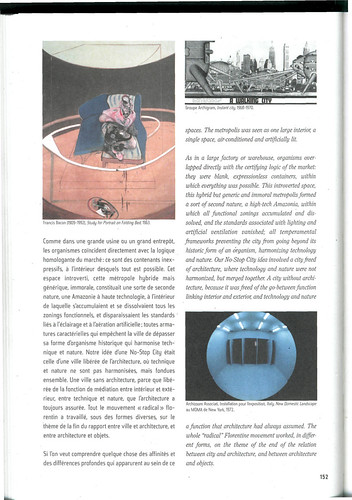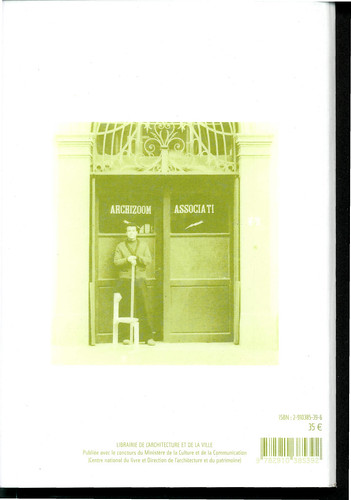No-Stop City, By Archizoom Associati (2006)
Saturday, April 21, 2007
 In 1969, the Archizoom group, while carrying out an experimental work in the field of design, also undertook a research on environment, mass culture and the city, which led to the project No-Stop City. For the first time, a book presents this work which coincides with the zenith of the Italian Radical movement. Gathering all the texts and drawings, this book reveals to us the "Endless City" intertwining architecture with objects and the triumphant consumer society, giving an interpretation where the repetition of a single central element, a building or a group of objects makes up, through a play of mirrors, a catatonic environment, a boundless supermarket, a now reached future to be composed. No-Stop City is a qualityless city in which individual can achieve his own housing conditions as a creative, freed and personal activity. The theoretical project was first published in the review Casabella in 1970, under the title: "City, assembly line of social issues, ideology and theory of the metropolis". As Andrea Branzi puts it, this projects implements "the idea of the fading away of architecture within metropolis". No-Stop City is a critical Utopia, a model of global urbanization where design is the essential conceptual instrument used in the mutation of living patterns and territories. This "endless city" is organized the same way as a factory or a supermarket. It presents an iterative pattern with multiple centres and a neutral, even and unbroken. No-Stop City offers itself as a kind of car park fitted out with inhabitable furniture whose use can be adapted to the circumstances. Interior spaces, air-conditioned and artificially lit, allow the organisation of new inhabiting typologies, open and unbroken, intended for new forms of association and community life. "Considering architecture as an intermediate stage of urban organization that has to be overstepped, No-Stop City establishes a direct link between metropolis and furnishing objects: the city becomes a series of beds, tables chairs and cupboards; the domestic and urban furniture fully coincide. To qualitative utopias, we oppose the only possible utopia: that of Quantity" (Andrea Branzi) *Archizoom Associati(Andrea Branzi, Gilberto Corretti, Paolo Deganello, Massimo Morozzi, Dario & Lucia Bartolini), first group of the Italian Radical Architecture movement (1966-1974).
In 1969, the Archizoom group, while carrying out an experimental work in the field of design, also undertook a research on environment, mass culture and the city, which led to the project No-Stop City. For the first time, a book presents this work which coincides with the zenith of the Italian Radical movement. Gathering all the texts and drawings, this book reveals to us the "Endless City" intertwining architecture with objects and the triumphant consumer society, giving an interpretation where the repetition of a single central element, a building or a group of objects makes up, through a play of mirrors, a catatonic environment, a boundless supermarket, a now reached future to be composed. No-Stop City is a qualityless city in which individual can achieve his own housing conditions as a creative, freed and personal activity. The theoretical project was first published in the review Casabella in 1970, under the title: "City, assembly line of social issues, ideology and theory of the metropolis". As Andrea Branzi puts it, this projects implements "the idea of the fading away of architecture within metropolis". No-Stop City is a critical Utopia, a model of global urbanization where design is the essential conceptual instrument used in the mutation of living patterns and territories. This "endless city" is organized the same way as a factory or a supermarket. It presents an iterative pattern with multiple centres and a neutral, even and unbroken. No-Stop City offers itself as a kind of car park fitted out with inhabitable furniture whose use can be adapted to the circumstances. Interior spaces, air-conditioned and artificially lit, allow the organisation of new inhabiting typologies, open and unbroken, intended for new forms of association and community life. "Considering architecture as an intermediate stage of urban organization that has to be overstepped, No-Stop City establishes a direct link between metropolis and furnishing objects: the city becomes a series of beds, tables chairs and cupboards; the domestic and urban furniture fully coincide. To qualitative utopias, we oppose the only possible utopia: that of Quantity" (Andrea Branzi) *Archizoom Associati(Andrea Branzi, Gilberto Corretti, Paolo Deganello, Massimo Morozzi, Dario & Lucia Bartolini), first group of the Italian Radical Architecture movement (1966-1974).
Andrea Branzi
Andrea Branzi (Florence, 1938) is an architect, a graphic designer and a theorist. He has been living and working in Milan since 1073. He is one of the protagonists of radical Italian Architecture who influenced a whole generation of architects from Franck O. Gehry to Daniel Libeskind, from Rem Koolhaas to Bernard Tschumi. He contributed to the creation of the Archizoom group, of which he was a member from 1964 to 1974. His "Radical Notes", published in the review entitled Casabella, participated in the theoretical debate of that period. From 1974 to 1976, Branzi became a member of Global Tools, a counter-school of architecture and design. Associated to studios of experimental industrial design as early as the end of the 60's (first Alchimia, then Memphis), Branzi has always been concerned with design research and promotion, which implies, to him, fresh relationships between men and objects. From 1983 to 1987, he directed the review entitled Modo and, in 1987, he was awarded the Compasso d'Oro for the whole of his career. He is the author of numerous publications such as La casa calda (1982), Animali domestici: lo stile neo-primitivo (1986), Nouvless de la métropole froide (1991) and Il design italiano 1964-1990 (1996), and has also curated many exhibitions. In parallel, Andrea Branzi has continued to conduct projects in architecture and urban planning through the concept of "weak urbanization".










Share No-Stop City via demonoid or karagarga(sign up here)!
at 8:35 PM